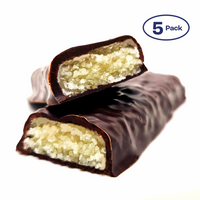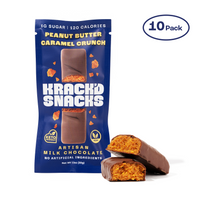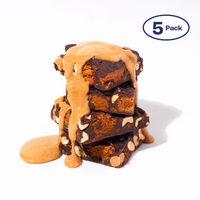We've all heard about vegan food, but are you familiar with vegan candy? It has become a trend among health-conscious individuals and for the right reasons. Let’s talk about it. Vegan candy skips animal-derived ingredients like dairy, honey, or gelatin. Unlike traditional sweets, vegan candies are dairy-free and made with plant-based alternatives like organic Ecuadorian cacao, organic cocoa butter, non-GMO roasted almonds and peanuts, and natural sweeteners like allulose and monk fruit.
Its plant-based approach aligns with the principle of clean eating. For those who are lactose intolerant, ethically conscious, and concerned about their children's health, these candies are excellent substitutes. But wait! While vegan may not contain gelatin, it can still be high in artificial flavors or added sugars that are not healthy. In this blog, we’ll show you how to identify ingredients that make vegan candy both clean and healthy.
What Makes Candy Truly Healthy (and Vegan)?
As the demand for vegan products rises, many products claim to be vegan. But are they healthy? Here’s how you can distinguish between a genuinely healthy treat and one that’s just labeled “ vegan.”
Ingredients to Look For in Clean Vegan Sweets
- Allulose, Monk Fruit : Natural, zero-glycemic sweeteners are the only sweeteners used by Krack’d Snacks. They’re natural, keto-friendly, and do not spike blood sugar.
- Organic Ecuadorian Cacao, Organic Cocoa Powder, Organic Coconut cream :These ingredients deliver polyphenols, antioxidants, healthy fats, and a rich and creamy texture, all while remaining dairy-free and ethically sourced.
- Non-GMO Tapioca Fiber (Non-IMO) : An excellent source of dietary fiber that supports digestive health and helps create the ideal texture in clean vegan sweets.
- Non-GMO Roasted Almonds, Organic Peanut Butter : These provide plant-based protein, fiber, and satiety, supporting glucose stability and longevity.
Ingredients to Avoid (Even If They’re Vegan)
- Artificial sweeteners and flavors : Many artificial sweeteners (eg, Sucralose, Aspartame) can disrupt gut microbiota and mainly impact glucose regulation.
- High fructose corn syrup (HFCS) : Associated with metabolic dysfunction and inflammation; never used in clean vegan sweets.
- Palm oil : While palm oil is vegan, it is advised to avoid it due to environmental and ethical concerns.
- Synthetic food dyes : Some food dyes are banned in certain countries due to health risks. It can cause allergies, hyperactivity, and even cancer.
Plant-Based Chocolate: A Better Way to Satisfy Your Sweet Tooth

The Nutritional Edge of Plant-Based Chocolate
Plant-based chocolate offers a compelling nutritional profile compared to conventional milk chocolate. Besides being dairy-free, it’s often made with quality ingredients like organic cacao and cocoa butter. These aren't just tasty. They also come with antioxidants that support heart and brain health. These chocolates are often lower in sugar, improving metabolic health. Additionally, this dairy-free candy is suitable for those with lactose intolerance or seeking to minimize saturated animal fats.
Texture and Taste: Does It Really Compare?
The era of chalky, waxy vegan chocolate is over. Vegan chocolate has come a long way. Brands today are creating rich, creamy textures without any dairy at all. They use substitutes like organic coconut cream, 100% natural peanut butter, and non-GMO tapioca fiber. As plant-based chocolate continues to evolve, it’s not just a substitute; it’s a category leader in both taste and nutrition.
Choosing the Right Vegan Candy: How to Read Labels Like a Pro
Don’t fall for greenwashing or trendy packaging. Here’s how to confidently choose the cleanest candy.
Label Reading Tips for Spotting Healthy Vegan Candy
Most people misunderstand plant-based candy as vegan candy. But they are not synonymous. Plant-based candies may still trace animal products, whereas vegan candies are strictly free of them. Look for certifications such as USDA Organic, Non-GMO project verified, and Vegan Society. A short, recognizable ingredient is usually a sign of clean vegan sweets. For instance, a bar with “Organic Ecuadorian Cacao, Allulose, Monk Fruit, and non-IMO Tapioca fiber” is far preferable to one with multiple sugars, fillers, or artificial additives.
Red Flags That Signal It’s Not So Healthy
Skip anything with a long list of ingredients you can't pronounce. If you see things like "natural flavors" or "fruit juice concentrate" listed multiple times, that’s a sign there’s more going on than the label lets on. These are often used to hide added sugars or fillers. Too many processed starches? That usually means the candy's cutting corners on both nutrition and taste.
Krack’d Snacks: The Ultimate Clean Candy Choice
Now that we know what to look for in a vegan candy and what makes it clean, you can still feel overwhelmed to find a brand that actually checks all the boxes. That’s why at Krack’d Snacks, we’ve made it our mission to create snacks that satisfy your cravings without compromising your clean lifestyle.
At Krack’d Snacks, we believe in full ingredient transparency and sourcing from trusted suppliers. Our treats use clean labels and are free from added sugar, artificial preservatives, and zero corn syrup. This is not all; every product is gluten-free, and packed with high-quality ingredients like allulose and monk fruit.
Even if you’re not vegan, these treats are so good you won’t believe they’re plant-based. One bite, and you’re hooked.
The Krack’d Way to Vegan Snacking

At the end of the day, we all want something to satisfy our sweet tooth without compromising on taste, texture, and flavor. Once you start paying attention to the ingredient list, it’s easier to make informed choices.
At Krack’d Snacks, we’re proud to partner only with trusted suppliers who share our values. We keep it real and clean without compromising flavor, taste, and texture.
Are you curious to make the switch to clean, satisfying vegan candy? Check out our vegan candy collection and see what plant-based snacking is really about.




